Articles
- Page Path
- HOME > J Korean Acad Nurs > Volume 46(4); 2016 > Article
-
Original Article
- A Structural Equation Model of Pressure Ulcer Prevention Action in Clinical Nurses
- Sook Ja Lee, Ok Kyoung Park, Mi Yeon Park
-
Journal of Korean Academy of Nursing 2016;46(4):572-582.
DOI: https://doi.org/10.4040/jkan.2016.46.4.572
Published online: August 31, 2016
1College of Nursing, Korea University, Seoul, Korea.
2Nursing Service Department, Korea University Ansan Hospital, Ansan, Korea.
- Address reprint requests to : Park, Ok Kyoung. Nursing Service Department, Korea University Ansan Hospital, 123, Jeokgeum-ro, Danwon-gu, Ansan-si, Gyeonggi-do, 15355, Korea. Tel: +82-31-412-5477, Fax: +82-31-412-5414, ok-sk81@korea.ac.kr
© 2016 Korean Society of Nursing Science
This is an Open Access article distributed under the terms of the Creative Commons Attribution NoDerivs License. (http://creativecommons.org/licenses/by-nd/4.0/) If the original work is properly cited and retained without any modification or reproduction, it can be used and re-distributed in any format and medium.
Abstract
-
Purpose
- The purpose of this study was to construct and test a structural equation model for pressure ulcer prevention action by clinical nurses. The Health Belief Model and the Theory of Planned Behavior were used as the basis for the study.
-
Methods
- A structured questionnaire was completed by 251 clinical nurses to analyze the relationships between concepts of perceived benefits, perceived barriers, attitude, subjective norm, perceived control, intention to perform action and behavior. SPSS 22.0 and AMOS 22.0 programs were used to analyze the efficiency of the hypothesized model and calculate the direct and indirect effects of factors affecting pressure ulcer prevention action among clinical nurses.
-
Results
- The model fitness statistics of the hypothetical model fitted to the recommended levels. Attitude, subjective norm and perceived control on pressure ulcer prevention action explained 64.2% for intention to perform prevention action.
-
Conclusion
- The major findings of this study indicate that it is essential to recognize improvement in positive attitude for pressure ulcer prevention action and a need for systematic education programs to increase perceived control for prevention action.
- 1. National Pressure Ulcer Advisory Panel. European Pressure Ulcer Advisory Panel. Pan Pacific Pressure Injury Alliance. Prevention and treatment of pressure ulcers: Clinical practice guideline. 2nd ed. Osborne Park, AU: Cambridge Media; 2014. p. 18–24.
- 2. Kim JM, Park JS. Development of an algorithm for the prevention and management of pressure ulcers. J Korean Acad Adult Nurs. 2010;22(4):353–364.
- 3. Chaboyer W, Gillespie BM. Understanding nurses' views on a pressure ulcer prevention care bundle: A first step towards successful implementation. J Clin Nurs. 2014;23(23-24):3415–3423. ArticlePubMedPDF
- 4. Nam MH, Lim JH. Analysis on the situation of inpatients with pressure ulcer by patient safety indicators. J Digit Policy Manag. 2012;10(3):197–205.
- 5. Samuriwo R. The impact of nurses' values on the prevention of pressure ulcers. Br J Nurs. 2010;19(15):S4S6S8Article
- 6. Yang NY, Moon SY. Perceived importance, educational needs, knowledge and performance concerning pressure ulcer care by clinical nurses. J Korean Acad Adult Nurs. 2009;21(1):95–104.
- 7. Gu MO, Lee EO. Health belief model and sick role behavior of Korean chronic ill patients. Korean Nurse. 1990;29(3):49–63.PubMed
- 8. Janz NK, Becker MH. The health belief model: A decade later. Health Educ Q. 1984;11(1):1–47.ArticlePubMedPDF
- 9. Kim YO. Theoretical analysis of health belief model and evaluation of usefulness on nursing discipline. J Sogang coll. 1994;13:417–437.
- 10. Källman U, Suserud BO. Knowledge, attitudes and practice among nursing staff concerning pressure ulcer prevention and treatment-a survey in a Swedish healthcare setting. Scand J Caring Sci. 2009;23(2):334–341. ArticlePubMed
- 11. Moore Z, Price P. Nurses’ attitudes, behaviours and perceived barriers towards pressure ulcer prevention. J Clin Nurs. 2004;13(8):942–951. ArticlePubMed
- 12. Strand T, Lindgren M. Knowledge, attitudes and barriers towards prevention of pressure ulcers in intensive care units: A descriptive cross-sectional study. Intensive Crit Care Nurs. 2010;26(6):335–342. ArticlePubMed
- 13. Tubaishat A, Aljezawi M, Al Qadire M. Nurses' attitudes and perceived barriers to pressure ulcer prevention in Jordan. J Wound Care. 2013;22(9):490–497. ArticlePubMed
- 14. Cullen Gill E, Moore Z. An exploration of fourth-year undergraduate nurses' knowledge of and attitude towards pressure ulcer prevention. J Wound Care. 2013;22(11):618–620. 622ArticlePubMed
- 15. Beeckman D, Defloor T, Schoonhoven L, Vanderwee K. Knowledge and attitudes of nurses on pressure ulcer prevention: A cross-sectional multicenter study in Belgian hospitals. Worldviews Evid Based Nurs. 2011;8(3):166–176. ArticlePubMed
- 16. Park S, Yang NY, Choi JS. Factors affecting attitudes and preventive practice of pressure ulcer among nurses. J Muscle Joint Health. 2013;20(1):43–51. Article
- 17. Russell-Babin K. Comparison of educational interventions to impact behavioral intent toward pressure ulcer prevention among nurses on medical surgical units[dissertation]. Fort Lauderdale, FL, Nova Southeastern University. 2013;1–180.
- 18. Yang SO. Effect of the perception of clinical nurses on the extent of nursing care for pressure ulcer patients[master's thesis]. Sunchon, Sunchon National University. 2010;1–75.
- 19. Shin KR, Kim M, Kang Y, Jung D, Eom JY, Kweon YR. Pressure ulcers in long-term care hospitals in Korea: Prevalence and risk factors. J Korean Gerontol Soc. 2012;32(1):115–127.
- 20. Lee YJ, Park S. Effects of pressure ulcer classification system education program on knowledge and visual discrimination ability of pressure ulcer classification and incontinence-associated dermatitis for hospital nurses. J Korean Biol Nurs Sci. 2014;16(4):342–348. Article
- 21. Jeong IS, Kim S, Jeong JS, Hong EY, Lim EY, Seo HJ, et al. Development of pressure ulcer management guideline by adaptation process. J Korean Clin Nurs Res. 2014;20(1):40–52.
- 22. Kim YI, Jung HS, Bae KH. Health promotion: Theory and application. Seoul: Episteme; 2007. p. 1–330.
- 23. Jee YO. Instrument development for the application of the theory of planned behavior. Korean J Nurs Query. 1993;2(2):102–115.
- 24. Becker MH. The health belief model and personal health behavior. Thorofare, NJ: Slack; 1974. p. 324–508.
- 25. Ajzen I. From intentions to actions: A theory of planned behavior. In: Kuhl J, Beckmann J, editors. Action control. Berlin, DE: Springer; 1985. p. 11–39.
- 26. Kim GS. Analysis structural equation modeling. Seoul: Hannarae Publishing Co.; 2010.
- 27. Ajzen I, Madden TJ. Prediction of goal-directed behavior: Attitudes, intentions, and perceived behavioral control. J Exp Soc Psychol. 1986;22(5):453–474.Article
- 28. Brindle CT, Malhotra R, O'Rourke S, Currie L, Chadwik D, Falls P, et al. Turning and repositioning the critically ill patient with hemodynamic instability: A literature review and consensus recommendations. J Wound Ostomy Continence Nurs. 2013;40(3):254–267. PubMed
- 29. Nash R, Edwards H, Nebauer M. Effect of attitudes, subjective norms and perceived control on nurses' intention to assess patients' pain. J Adv Nurs. 1993;18(6):941–947.ArticlePubMed
- 30. Black JM, Edsberg LE, Baharestani MM, Langemo D, Goldberg M, McNichol L, et al. Pressure ulcers: Avoidable or unavoidable? Results of the National pressure ulcer advisory panel consensus conference. Ostomy Wound Manage. 2011;57(2):24–37.
REFERENCES
Figure & Data
REFERENCES
Citations

- Knowledge and Visual Differentiation Ability of the Pressure Injury Classification System and Incontinence-Associated Dermatitis among Hospital Nurses: A Descriptive Study
Seungmi Park, Eun Jung Kim, Son Ja Lee, Eun Jeong Kim, Ji Yeon Lee, Jung Eun Hong
Healthcare.2024; 12(2): 145. CrossRef - A Study of Pandemic Prevention Health Behavior in Adults
Mihyeon Seong, Kyungeui Bae
International Journal of Environmental Research and Public Health.2022; 19(13): 8181. CrossRef - Factors associated with preventive behaviors for COVID-19 among adolescents in South Korea
Sunhee Park, Sumi Oh
Journal of Pediatric Nursing.2022; 62: e69. CrossRef - Effects of Attitude, Barriers/Facilitators, and Visual Differentiation on Oral Mucosa Pressure Ulcer Prevention Performance Intention
Min Kyeong Kang, Myoung Soo Kim
Healthcare.2021; 9(1): 76. CrossRef - Patient Safety Management Activities of Clinical Nurse: A Modified Theory of Planned Behavior
Nam Yi Kim, Sun Young Jeong
Journal of Korean Academy of Nursing Administration.2019; 25(5): 384. CrossRef - Canonical Correlation between Knowledge-Barriers/Facilitators for Pressure Ulcer Prevention Nursing Variables and Attitude-Performance Variables
Myoung Soo Kim, Jung Mi Ryu
Journal of Health Informatics and Statistics.2019; 44(3): 227. CrossRef - Development of the Unit Specialist-led Pressure Ulcer Nursing Algorithm
Yuna Noh, Jia Lee
Korean Journal of Adult Nursing.2019; 31(4): 365. CrossRef - Using the theory of planned behaviour to predict nurse's intention to undertake dual practice in China: A multicentre survey
Xiaoling Bai, Anni Wang, Virginia Plummer, Louisa Lam, Wendy Cross, Ziyao Guan, Xin Hu, Mei Sun, Siyuan Tang
Journal of Clinical Nursing.2019; 28(11-12): 2101. CrossRef - A Structural Equation Modeling of Prostate Cancer Screening Intention
Ji Hye Jeong, Nam Hee Park
Journal of Korean Academy of Community Health Nursing.2019; 30(4): 471. CrossRef
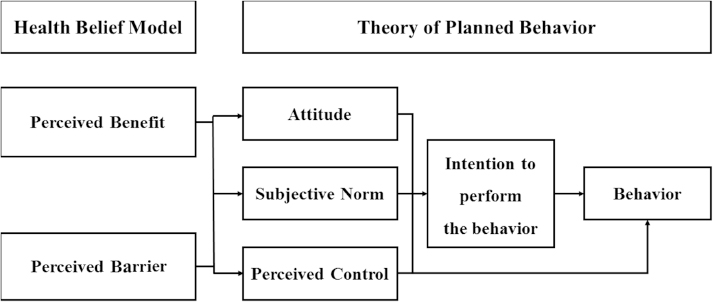
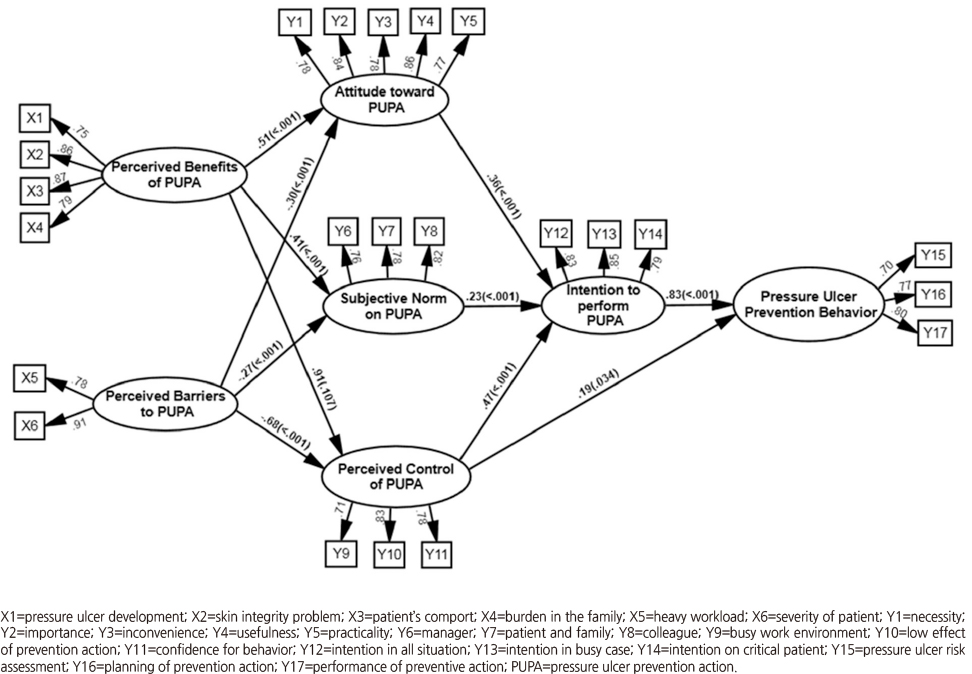
Figure 1
Figure 2
General Characteristics and Descriptive Statistics of Observed Variables
*Except for non–response; PUPA=pressure ulcer prevention action.
Correlation Relations between Variables and Verification of Construct Validity
PUPA=Pressure ulcer prevention action; AVE=Average Variance Extracted; CR=Construct Reliability;r=correlation estimate.
Standardized Estimates, C.R., SMC, Standardized Direct, Indirect, and Total Effects for the Hypothetical Model
C.R.=Critical ratio; SMC=Squared multiple correlation; β=Standardized regression coefficients; PUPA=Pressure ulcer prevention action.
*Except for non–response; PUPA=pressure ulcer prevention action.
PUPA=Pressure ulcer prevention action; AVE=Average Variance Extracted; CR=Construct Reliability;r=correlation estimate.
C.R.=Critical ratio; SMC=Squared multiple correlation; β=Standardized regression coefficients; PUPA=Pressure ulcer prevention action.
 KSNS
KSNS
 E-SUBMISSION
E-SUBMISSION


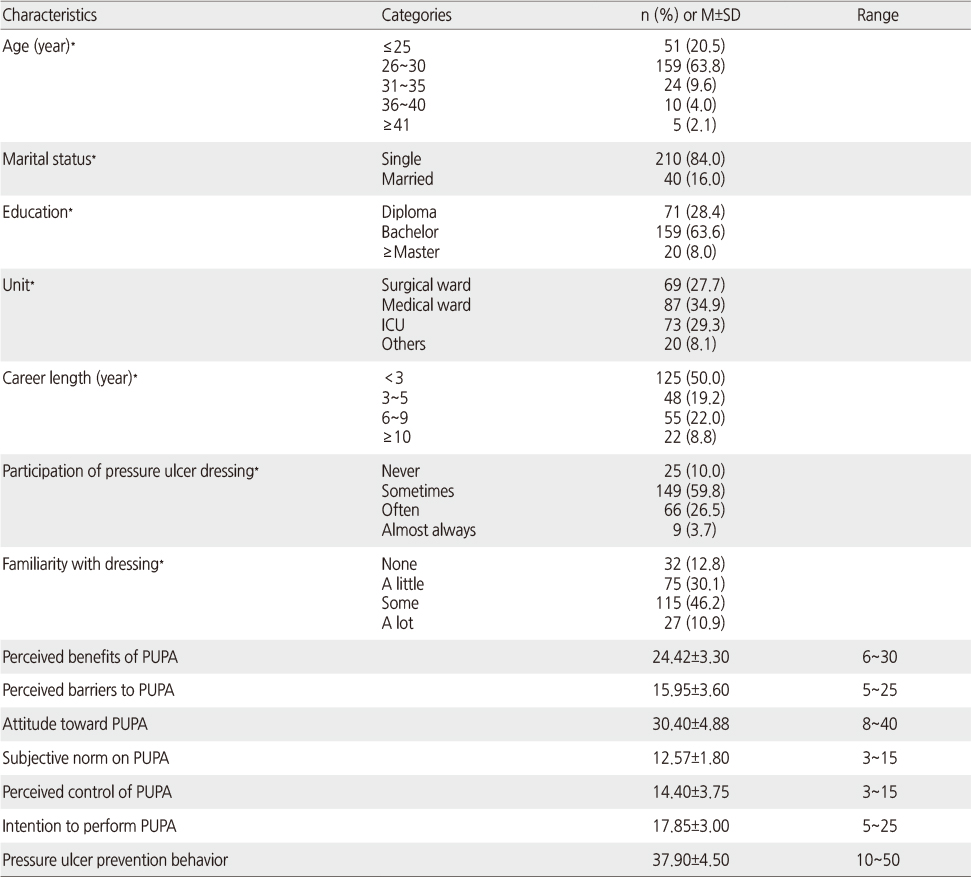
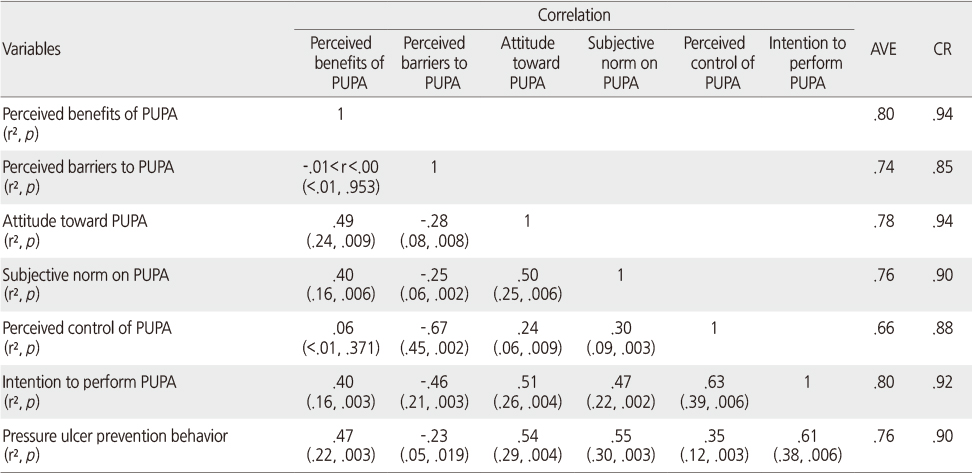
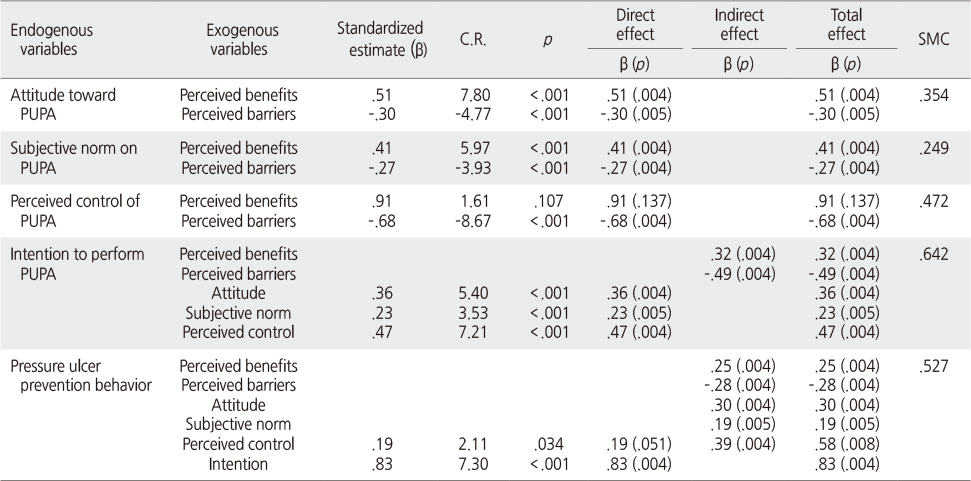
 Cite
Cite

